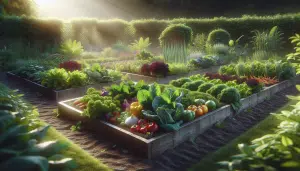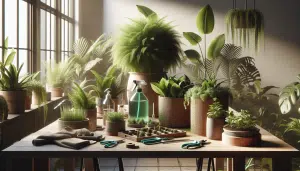Raised Bed Gardening Ideas That May Change How You Grow
Lily Carter October 15, 2025
Discover how raised bed gardening can transform any home landscape—from tiny patios to spacious yards. This guide walks through creative designs, setup tips, soil secrets, and plant choices, weaving in sustainability and real-world inspiration. Learn what sets this growing method apart for productivity and accessibility.
Why Raised Bed Gardening Grows in Popularity
Many homeowners are turning to raised bed gardening as it offers improved soil control, less back strain, and fewer weeds compared to traditional gardens. The elevated structure keeps pathways defined and plants protected, which helps reduce common garden struggles like soil compaction and pest infestations. Raised beds can also adapt to almost any space, from compact balconies to sprawling lawns.
Another big advantage is that raised beds warm up faster in spring, extending the growing season by days or even weeks. Gardeners eager to start growing vegetables early are drawn to this benefit. The well-drained soil environment also allows for better root health. With a raised bed, it’s simple to organize plants for rotation, companion planting, or specific soil blends per crop.
Each raised garden becomes an opportunity for creativity—shaped from wood, stone, or recycled materials—adding both function and style to home landscapes. Customizing height and width ensures accessibility for people of all ages and mobility levels. This customizable nature is part of the reason raised beds are embraced in modern, sustainable home design (Source: https://extension.umn.edu/planting-and-growing-guides/raised-bed-gardens).
Planning Your Raised Bed: Shapes, Materials, and Layouts
Successful raised bed gardening starts with thoughtful planning—begin by choosing an area with at least six hours of sunlight per day. Decide on the shape: classic rectangles, U-shaped beds for easy reach, or even L-shaped designs for corners. Some spaces can benefit from round or multi-level beds for visual interest and efficient use of awkward corners.
The choice of materials influences longevity, appearance, and even soil chemistry. Cedar and redwood are popular for their natural resistance to decay, but recycled composites or metal planters are also growing in use for modern gardens. Consider the height: typically, 12 to 24 inches allows most vegetables to thrive. Ensure walkways are wide enough for easy access and maintenance.
Arranging multiple beds in rows or blocks means you can group plants by water needs, sun exposure, or rotation schedules. Strategic layout manages foot traffic and reduces compaction. Incorporate trellises, drip irrigation, or other supports during planning to maximize efficiency and yields while keeping daily care convenient (Source: https://www.rhs.org.uk/advice/profile?pid=944).
Secrets of Building and Filling the Ideal Raised Bed
Building a raised vegetable bed doesn’t require advanced carpentry. Using rot-resistant woods like cedar offers durability, while simple assembly kits provide a starter-friendly approach. Place beds on level ground and, if possible, add a layer of landscape fabric underneath to prevent weeds and pests from reaching plant roots.
The real magic lies in the soil blend. Layering organic matter—compost, rotted manure, or leaf mold—over a base of topsoil creates a fertile, well-draining environment. Mixing in a balanced amount of sand or coconut coir can help further improve texture and retention. Aim for a blend that’s loose, rich, and easy to work.
Once filled, avoid stepping into the bed to keep soil loose. Mulch after planting to reduce evaporation and suppress weeds. Well-prepared raised beds hold nutrients and moisture more effectively, which is key for healthy, productive plants throughout the season (Source: https://hgic.clemson.edu/factsheet/raised-bed-gardening/).
Smart Plant Choices for Raised Beds
Choosing the right plants is easier in raised beds thanks to precise soil control. Leafy greens, carrots, radishes, and beets thrive in the loose, deep soil. Tomatoes, peppers, and bush beans also benefit from the warmth and good drainage. For kitchens, herbs like basil, thyme, and parsley flourish along bed edges where harvesting is a breeze.
Crowd taller crops like trellised peas, beans, or cucumbers at the north side so they don’t shade out sun-loving neighbors. Try succession planting: as soon as an early crop is harvested, replant with another type. This approach keeps beds productive from spring through fall, maximizing food and flower harvests per square foot.
Interplanting flowers such as marigolds or nasturtiums can help attract pollinators and deter certain pests naturally. This creates a healthier micro-ecosystem within your beds and supports sustainable gardening. Experimenting with companion planting strategies offers continual learning and evolving results for every season (Source: https://extension.psu.edu/raised-bed-gardens).
Watering, Mulching, and Ongoing Care Made Simple
Maintaining raised beds is different from in-ground gardens. The enclosed soil dries more quickly, demanding consistent attention to watering. Soaker hoses or drip irrigation systems simplify regular moisture delivery, especially during dry spells. Water in the morning to reduce evaporation and prevent disease issues linked to overnight dampness.
Mulching is a powerful tool. Use straw, shredded bark, or compost to blanket the soil, conserving moisture and discouraging weeds. This insulates roots against heat swings and improves soil as the mulch breaks down. Monitor the mulch layer throughout the season—top off as needed to retain benefits.
Routine tasks are easy to manage in raised beds because everything is contained and clearly visible. Remove debris, thin crowded seedlings, and check for signs of pests. This proactive maintenance keeps plants healthy and encourages plentiful harvests with less work and hassle (Source: https://mastergardener.extension.wisc.edu/article/raised-bed-gardening/).
Creative Ideas for Raised Bed Gardens in Small Spaces
Smaller yards and balconies don’t need to miss out—compact raised beds, vertical planters, or stacked crates let gardeners grow vegetables and herbs with surprising abundance. Building beds along fences or house walls saves room and can create attractive green screens. Even unused corners can become productive with cleverly shaped containers.
Vertical trellises or hanging planters multiply growing area upward rather than outward. Mix trailing herbs with upright beans, or let cherry tomatoes spill over the side of the bed. Wheeled beds or lightweight containers allow flexible placement and easy seasonal rearrangement for light or shelter as needed.
Including a bench, stepping stones, or decorative stonework transforms tiny raised bed gardens into inviting nooks. Integrate edible and ornamental plants together so every inch delights the eye and provides something useful or tasty. Efficient, layered plantings bring vibrant growth to courtyards, patios, and even rooftops (Source: https://www.gardeners.com/how-to/small-space-gardening-raised-beds/8592.html).
References
1. University of Minnesota Extension. (n.d.). Raised bed gardens. Retrieved from https://extension.umn.edu/planting-and-growing-guides/raised-bed-gardens
2. Royal Horticultural Society. (n.d.). Raised beds. Retrieved from https://www.rhs.org.uk/advice/profile?pid=944
3. Clemson Cooperative Extension. (n.d.). Raised bed gardening. Retrieved from https://hgic.clemson.edu/factsheet/raised-bed-gardening/
4. Penn State Extension. (2023). Raised bed gardens. Retrieved from https://extension.psu.edu/raised-bed-gardens
5. UW-Madison Extension. (n.d.). Raised bed gardening. Retrieved from https://mastergardener.extension.wisc.edu/article/raised-bed-gardening/
6. U.S. Environmental Protection Agency. (n.d.). Benefits of raised bed gardens. Retrieved from https://www.epa.gov/greenacres/raised-bed-garden-benefits







